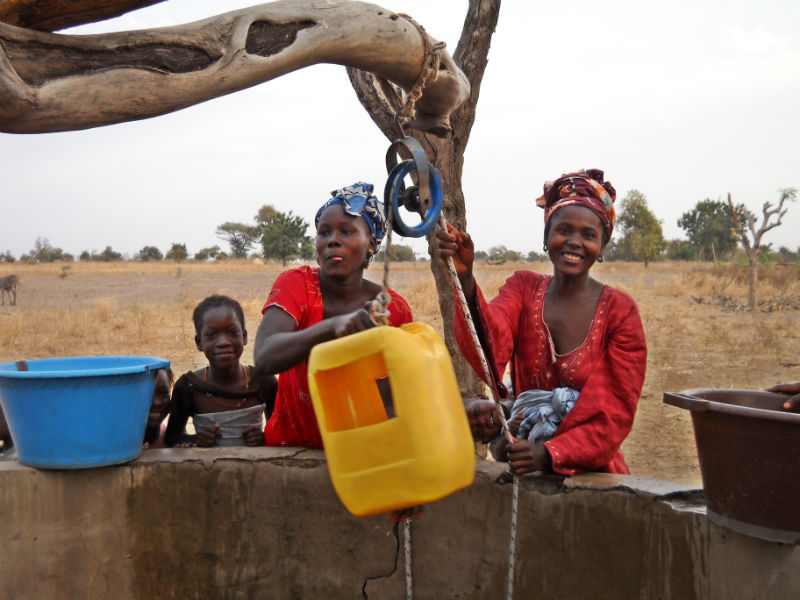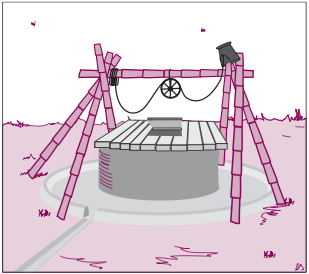Difference between revisions of "绳子与水桶"
| (18 intermediate revisions by 2 users not shown) | |||
| Line 1: | Line 1: | ||
| + | {{Language-box|english_link= Rope and bucket | french_link= Coming soon | spanish_link= Coming soon | hindi_link= Coming soon | malayalam_link= Coming soon | tamil_link= Coming soon | korean_link= Coming soon | chinese_link=绳子与水桶 | indonesian_link= Coming soon | japanese_link= Coming soon }} | ||
[[Image:rope and bucket icon.png|right|80px]] | [[Image:rope and bucket icon.png|right|80px]] | ||
[[Image:RopeandBucketphoto.jpg|thumb|right|200px|绳子与水桶装置。塞内加尔的考拉克地区,法斯•图库勒尔,图片来源: | [[Image:RopeandBucketphoto.jpg|thumb|right|200px|绳子与水桶装置。塞内加尔的考拉克地区,法斯•图库勒尔,图片来源: | ||
| − | [http://appropriateprojects.com/node/731 | + | [http://appropriateprojects.com/node/731 Fass Toucouleur(法斯•图库勒尔)水井改善工程]]] |
| − | __NOTOC__ | + | __NOTOC__ |
| − | + | 绳桶装置主要用于手工挖掘井。将桶系在绳子上并降到水中,桶遇水后会下沉并打满水,随后再用绳子将其拉起。绳子可以由手拉动、运用滑轮或绕在绞盘上。有时,畜力牵拉可与滑轮一同使用。改良的装置中,绳子要绕过滑轮,还要用两只水桶(绳子两端各一只)。对于浅于10米的水,可使用带有软管的绞盘,软管从水桶底部连到井的出水口。然而,即使水井有防护装置,卫生情况仍较差。 | |
===适宜条件=== | ===适宜条件=== | ||
| Line 16: | Line 17: | ||
- 通过畜力运作的绳与双桶提水装置每分钟能供水200多升<br> | - 通过畜力运作的绳与双桶提水装置每分钟能供水200多升<br> | ||
| valign="top" | - 通过人力运作的绳桶提水装置每分钟仅能供水15升<br> | | valign="top" | - 通过人力运作的绳桶提水装置每分钟仅能供水15升<br> | ||
| − | - | + | - 即使不用灌溉时,动物仍需要全年的养护<br> |
- 传统的人畜运作设计相对低效(10-40%)<br> | - 传统的人畜运作设计相对低效(10-40%)<br> | ||
|} | |} | ||
| Line 22: | Line 23: | ||
===建造、运作与维护=== | ===建造、运作与维护=== | ||
| − | [[Image:RopeandBucketdrawing.jpg|thumb|right|200px| | + | [[Image:RopeandBucketdrawing.jpg|thumb|right|200px|绳桶提水装置。图片来源:WHO(世界卫生组织)]] |
| − | + | 深度范围:0–15米(有时甚至更深)。 | |
| − | + | 产水量:10米深时0.25 升/秒。 | |
| − | + | 从地下打水最简易、廉价的方法仍是运用绳子和水桶在宽浅的井中提水。这类井最深能达100米,但一般都不会超过45米深。绳桶提水装置可由人力或畜力驱动。通常,人力绳桶装置每分钟能从10-15米深处打出10-15升水,而畜力装置每分钟能从15米深处打出150升水。在畜力驱动的绳桶提水装置中,系在桶上的绳子穿过滑轮固定在动物身上。为了将水提起,动物会从一个5-10度的斜土坡上往下走。 | |
| − | + | 可用能自动清空的容器(或称mohte)来替代水桶。这一装置包含一个形似漏斗的皮制容器。这样的容器通常能容纳100到150升水,每分钟能从最深9米处打水约130升。 | |
| − | + | 绳桶提水装置也能改装成双桶,打水时两桶上下交替进行。在此情况下,拉绳的动物在环形道上移动,借助中间的旋转杆、绳子和滑轮的作用,使水桶上下活动。每个水桶能容纳最多70升水。水桶底部有铰链翻片,起到阀门的作用。井中装有导杆,以控制水桶的活动。在运作过程中,水桶会自动装水和倒水。这一装置每分钟能从最深5米处打水约230升。 | |
====维护==== | ====维护==== | ||
| − | + | 水桶的升降由放绳和拉绳、或旋转绞盘来控制。一定要小心防止绳子或水桶受到污染。预防性的维护包括给绞盘或滑轮的轴承上油。小型维修仅限于修补水桶和软管上的洞眼、重连水桶上的铰链及修复绞盘的轴承或把柄。所有的小型维修可由当地人完成,工具和材料可从社区或本地区就地取材。大型维修、置换主要包括更换水桶、软管、绳子及部分或整体的绞盘。编织尼龙绳可用两年,但尼龙搓绳或琼麻绳只能用几个月。优质软管可以使用两年以上,大多数水桶则是一年(由材料与质量决定)。当人们使用自己的绳子与水桶时,不需要额外的组织工作。如果是社区水井,则通常由社区委员会组织水井的维护与清洁,以及绞盘维护,等。可由特别的募集活动来提供大多数修补用的资金。 | |
| − | |||
| − | + | Brikke和Bredero在其著作''[http://www.who.int/water_sanitation_health/hygiene/om/linkingintro.pdf 社区供水与公共卫生中的技术选择与运行维护:规划师与项目工作者参考资料]'' 中,推荐下列图表中的运行与维护工作: | |
[[File:rope and bucket OM.jpg]] | [[File:rope and bucket OM.jpg]] | ||
====潜在问题==== | ====潜在问题==== | ||
| − | — | + | — 劣质绳子会很快损坏(如,琼麻绳只能用几个月);<br> |
| − | — | + | — 水桶可能会掉入井中……为防止这一点,社区可以留一个备用的水桶,并放在保护笼中;<br> |
| − | — | + | — 绞盘和软管装置中的软管会时常破裂;<br> |
| − | — | + | — 卫生状况不佳,尤其是绳子或水桶与使用者的手或地面接触后;<br> |
| − | — | + | — 公共井比家庭私有井更容易遭受污染,应当尽可能推行后者;<br> |
| − | — | + | — 绳桶装置只适用于有限深度。 |
===成本=== | ===成本=== | ||
| − | + | 在利比里亚,从6美金一个塑料水桶和5米长的绳子,到150美金含一只绞盘、软管和封闭式的上层装置不等(Milkov, 1987)。 | |
===实地经验=== | ===实地经验=== | ||
| − | + | 使用地区:全世界。 | |
===指南、视频与链接=== | ===指南、视频与链接=== | ||
| − | * [http://www.fao.org/docrep/010/ah810e/AH810E05.htm 3. | + | * [http://www.fao.org/docrep/010/ah810e/AH810E05.htm 3. 水泵与提水技术评述]. FAO(联合国粮农组织). |
| − | * [http://www.cd3wd.com/cd3wd_40/cd3wd/Practact/KnO-100410-human_animal_water_lifters.pdf | + | * [http://www.cd3wd.com/cd3wd_40/cd3wd/Practact/KnO-100410-human_animal_water_lifters.pdf 用于灌溉的人力与畜力提水装置] (PDF全文). Practical Action(实践基金会). |
| − | * | + | * 提水方法广泛指南:[http://docs.watsan.net/Downloaded_Files/PDF/Baumann-2010-WASH.pdf WASH(水、环境卫生与个人卫生)技术信息包.] UNICEF(联合国儿童基金会),2010. |
===鸣谢=== | ===鸣谢=== | ||
| − | * Brikke, | + | * Brikke, François与Bredero, Maarten. [http://www.washdoc.info/docsearch/title/117705 社区供水与公共卫生中的技术选择与运行维护:规划师与项目工作者参考资料] 或([http://www.who.int/water_sanitation_health/hygiene/om/wsh9241562153/en/ 其它链接]). World Health Organization(世界卫生组织)和 IRC Water and Sanitation Centre(IRC水与卫生中心).瑞士日内瓦 2003. |
| − | * [http://practicalaction.org/practicalanswers/product_info.php?products_id=378&attrib=1 | + | * [http://practicalaction.org/practicalanswers/product_info.php?products_id=378&attrib=1 用于灌溉的人力与畜力提水装置.] Practical Action(实践基金会). |
Latest revision as of 14:41, 11 January 2016
| |
|
|
|
|
|
|
|
|

绳桶装置主要用于手工挖掘井。将桶系在绳子上并降到水中,桶遇水后会下沉并打满水,随后再用绳子将其拉起。绳子可以由手拉动、运用滑轮或绕在绞盘上。有时,畜力牵拉可与滑轮一同使用。改良的装置中,绳子要绕过滑轮,还要用两只水桶(绳子两端各一只)。对于浅于10米的水,可使用带有软管的绞盘,软管从水桶底部连到井的出水口。然而,即使水井有防护装置,卫生情况仍较差。
适宜条件
| 优势 | 不足 |
|---|---|
| - 技术简易,造价与维护费用低廉 - 最深可在100米处运作 |
- 通过人力运作的绳桶提水装置每分钟仅能供水15升 - 即使不用灌溉时,动物仍需要全年的养护 |
建造、运作与维护
深度范围:0–15米(有时甚至更深)。
产水量:10米深时0.25 升/秒。
从地下打水最简易、廉价的方法仍是运用绳子和水桶在宽浅的井中提水。这类井最深能达100米,但一般都不会超过45米深。绳桶提水装置可由人力或畜力驱动。通常,人力绳桶装置每分钟能从10-15米深处打出10-15升水,而畜力装置每分钟能从15米深处打出150升水。在畜力驱动的绳桶提水装置中,系在桶上的绳子穿过滑轮固定在动物身上。为了将水提起,动物会从一个5-10度的斜土坡上往下走。
可用能自动清空的容器(或称mohte)来替代水桶。这一装置包含一个形似漏斗的皮制容器。这样的容器通常能容纳100到150升水,每分钟能从最深9米处打水约130升。
绳桶提水装置也能改装成双桶,打水时两桶上下交替进行。在此情况下,拉绳的动物在环形道上移动,借助中间的旋转杆、绳子和滑轮的作用,使水桶上下活动。每个水桶能容纳最多70升水。水桶底部有铰链翻片,起到阀门的作用。井中装有导杆,以控制水桶的活动。在运作过程中,水桶会自动装水和倒水。这一装置每分钟能从最深5米处打水约230升。
维护
水桶的升降由放绳和拉绳、或旋转绞盘来控制。一定要小心防止绳子或水桶受到污染。预防性的维护包括给绞盘或滑轮的轴承上油。小型维修仅限于修补水桶和软管上的洞眼、重连水桶上的铰链及修复绞盘的轴承或把柄。所有的小型维修可由当地人完成,工具和材料可从社区或本地区就地取材。大型维修、置换主要包括更换水桶、软管、绳子及部分或整体的绞盘。编织尼龙绳可用两年,但尼龙搓绳或琼麻绳只能用几个月。优质软管可以使用两年以上,大多数水桶则是一年(由材料与质量决定)。当人们使用自己的绳子与水桶时,不需要额外的组织工作。如果是社区水井,则通常由社区委员会组织水井的维护与清洁,以及绞盘维护,等。可由特别的募集活动来提供大多数修补用的资金。
Brikke和Bredero在其著作社区供水与公共卫生中的技术选择与运行维护:规划师与项目工作者参考资料 中,推荐下列图表中的运行与维护工作:
潜在问题
— 劣质绳子会很快损坏(如,琼麻绳只能用几个月);
— 水桶可能会掉入井中……为防止这一点,社区可以留一个备用的水桶,并放在保护笼中;
— 绞盘和软管装置中的软管会时常破裂;
— 卫生状况不佳,尤其是绳子或水桶与使用者的手或地面接触后;
— 公共井比家庭私有井更容易遭受污染,应当尽可能推行后者;
— 绳桶装置只适用于有限深度。
成本
在利比里亚,从6美金一个塑料水桶和5米长的绳子,到150美金含一只绞盘、软管和封闭式的上层装置不等(Milkov, 1987)。
实地经验
使用地区:全世界。
指南、视频与链接
- 3. 水泵与提水技术评述. FAO(联合国粮农组织).
- 用于灌溉的人力与畜力提水装置 (PDF全文). Practical Action(实践基金会).
- 提水方法广泛指南:WASH(水、环境卫生与个人卫生)技术信息包. UNICEF(联合国儿童基金会),2010.
鸣谢
- Brikke, François与Bredero, Maarten. 社区供水与公共卫生中的技术选择与运行维护:规划师与项目工作者参考资料 或(其它链接). World Health Organization(世界卫生组织)和 IRC Water and Sanitation Centre(IRC水与卫生中心).瑞士日内瓦 2003.
- 用于灌溉的人力与畜力提水装置. Practical Action(实践基金会).


